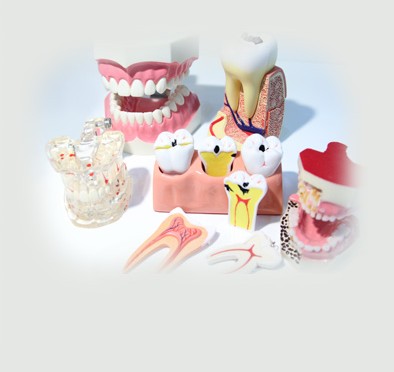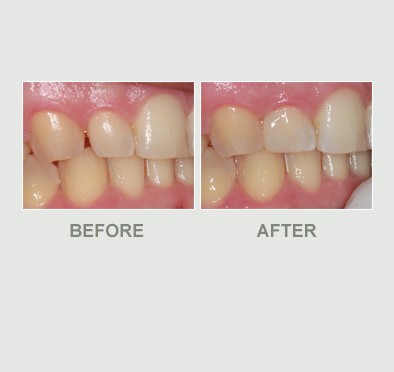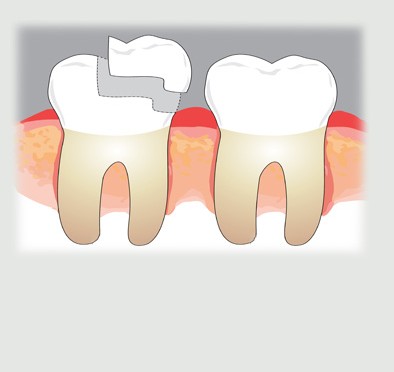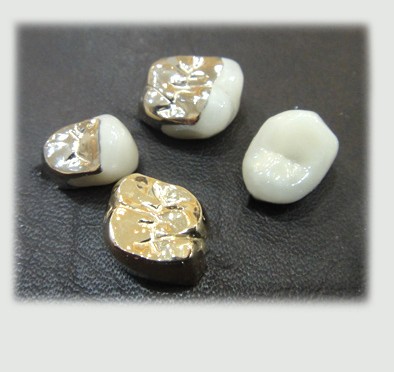Teeth Restoration
- Introduction
- Fillings
- Inlays / Onlays
- Crowns
Introduction
When part of the tooth becomes damaged, we can repair by partial dental restoration.
Potential causes of tooth damage:
- Dental caries
- Breaking tooth from accident
- Crack tooth
- Chemical damage
- Mechanical damage
- Attrition
- Abrasion
- Tooth surface loss (TSL)
There are several methods to restore each tooth depending on size of damage, position of damage, position of the tooth.
Clinical and x-ray examinaition are requires to evaluate which treatment is a proper solution.
In case that the damage is too extensive to the central layer of the tooth, root canal treatmentmay nescessary.
Certain cases, the damage also involve into the gum or under gum, gum treatment such ascrown lengthening may also needed.

Fillings
A dental filling is a method to replace damaged tooth structure such as dental caries ( decay or cavities ) case or broken parts.
In addition, we can also use dental fillings for cosmetic treatments such as gap closure, tooth shapetransformation such as facing or veneer and etc.
There are 2 kinds of dental fillings
1. Composite filling
Nowadays, we use composite filing or tooth color filling as first treatment of choice.
2. Amalgam filling

Inlays / Onlays
Dental Inlay and onlay are alternative dental restorations, which offer a better solution to tooth decay or other damages. Both are often used to replace the traditional dental fillings Both are fabricated indirectly from a dental lab before being put into the tooth but dental fillings are applied directly into the tooth.
The term of “onlay” is used when the extent of the damage requires inclusion of one or more cusps (points) of the tooth or full coverage of the biting surface.
Advantages:
1. Superior Fit: Both inlay and onlay offer a conservative preparation that preserves as much healthy tooth as possible.
2. Tooth Color inlay that made from ceramic provide better color durability than traditional dental filling.
3. Better Contact and contour reducing food impaction between each tooth.
4. Strength and Stability: Inlay and onlay are extremely stable restoration.The superior fit and durable material make both as stable choices that can strengthen a damaged tooth.
5. Weak Tooth Protector: An onlay can protect the weak areas of the tooth and help preserve tooth structure and fix decayed or damaged areas, helping to ensure functional longevity
The Procedures:
Treatments requires at least 2 visits.
1. The first visit is to prepare for laboratory process.
A temporary inlay or onlay, which has the same shape as final restoration will be input during this visit to protect the tooth while waiting for the final restoration to be fabricated.
2. The second visit is for inlay insertion and cementation.
Cost of inlay and onlay depends on the type of material used and size of inlay or onlay. Gold can be more expensive than other materials and porcelain while the larger onlay costs more than smaller inlay.

Crowns
Crown is a full coverage dental restoration that requires teeth preparation to make a room for crown.
Pros:
- Increase strength
- Increase stability
- Increase durability
- Cover damaged area to prevent or eliminate tooth sensitiveness
- For some cases, crown is done for cosmetic improvement
Cons:
- Tooth preparation is required
- Cost more than direct restorations such as amalgam or dental composite
Types:
1. Full metal crown
The metal is made of gold and suitable for patients who have habit of strong bite or extreme overnight grinding and short clinical posterior tooth length.
However, we do not recommend using this type of crown for cosmetic reason.
2. All ceramic crown
These crowns have no metal component and are considered for cosmetic work.
These products include:
3. Porcelain fuse to metal crown
Porcelain or ceramic is used for outer surface while metal is used for substructure. There are many kinds of metalsubstructure:
3.1) Precious metal or high gold crown
3.2) Semi precious metal crown
3.3) Palladium
3.4) Non precious crown
We recommend patients to use either porcelain fuse to high gold or all ceramic crowns as these crowns provide the best marginal seal, cosmetic result, and strength.
If patients do not have any other problems, such as root canal infection or gum disease, this crown work can be done within 5-7 days.








